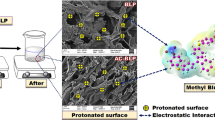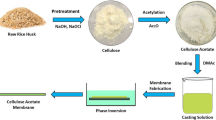Abstract
In this work, the effectiveness of native and chemically modified rice bran to remove heavy metal Pb(II) ions from aqueous solution was examined. Chemical modifications with some simple and low-cost chemicals resulted in enhancement of the adsorption capacities and had faster kinetics than native rice bran. Experiments were conducted in shake flasks to monitor the upshot of parameters over a range of pH, initial Pb(II) concentrations and contact times using a batch model study. The sorption capacities q (mg g−1) increased in the following order: NaOH (147.78), Ca(OH)2 (139.08), Al(OH)3 (127.24), esterification (124.28), NaHCO3 (118.08), methylation (118.88), Na2CO3 (117.12) and native (80.24). The utmost uptake capacity q (mg g−1) was shown by NaOH-pretreated rice bran. The results showed that, using NaOH-modified rice bran, the chief removal of Pb(II) was 74.54 % at pH 5, primary Pb(II) concentration 100 mg L−1 and contact time 240 min. Equilibrium isotherms for the Pb(II) adsorption were analyzed by Langmuir and Freundlich isotherm models. The Langmuir isotherm model, showing Pb(II) sorption as accessible through the high value of the correlation coefficient (R 2 = 0.993), showed a q max value of 416.61 mg g−1. The kinetic model illustrated adsorption rates well, depicted by a second order, which gives an indication concerning the rate-limiting step. Thermodynamic evaluation of the metal ion ∆G o was carried out and led to the observation that the adsorption reaction is spontaneous and endothermic in nature. NaOH chemically modified rice bran was a superb biosorbent for exclusion of Pb(II) and proved to be excellent for industrial applications.










Similar content being viewed by others
References
Amuda OS, Giwa AA, Bello IA (2007) Removal of heavy metal from industrial wastewater using modified activated coconut shell carbon. Biochem Eng J 36(2):174–181
Bulut Y, Baysal Z (2006) Removal of Pb(II) from wastewater using wheat bran. J Environ Manag 78(2):107–113
Chang CY, Tsai WT, Ing CH, Chang CF (2003) Adsorption of polyethylene glycol (PEG) from aqueous solution onto hydrophobic zeolite. J Coll Interf Sci 260(2):273–279
Chang P, Wang X, Yu S, Wu W (2007) Sorption of Ni(II) on Na-rectorite from aqueous solution: effect of pH, ionic strength and temperature. Colloids Surf A 302(1–3):75–81
Costodes VCT, Fauduet H, Porte C, Delacroix A (2003) J Hazard Mater 105(1-3):121–142
Dakiky M, Khamis M, Manassra A, Mereb M (2002) Selective adsorption of chromium(VI) in industrial wastewater using low-cost abundantly available adsorbents. Adv Environ Res 6(4):533–540
Diniz V, Volesky B (2005) Effect of counter ions on lanthanum biosorption by Sargassum polycystum. Water Res 39(11):2229–2236
Faisal M, Hasnain S (2004) Microbial conversion of Cr(VI) into Cr(III) in industrial effluent. Afr J Biotechnol 3(11):610–617
Feng N, Guo X, Liang S (2010) Enhanced Cu (II) adsorption by orange peel modified with sodium hydroxide. Trans Nanoferrous Metals Soc China 20(1):146–152
Gadd GM (1988) Accumulation of metals by microorganisms and algae. In: Rem HJ (ed) Biotechnology. Germany, Weinheim, pp 401–433
Hanif MA, Nadeem R, Bhatti HN, Ahmad NR, Ansari TM (2007) Ni(II) biosorption by Cassia fistula (Golden Shower) biomass. J Hazard Mater B 139:345–355 (View Record in Scopus | Cited By in Scopus (59))
Ho YS, Mckay G (1999) Pseudo-second order model for sorption processes. Proc Biochem 34(5):451–465
Holan ZR, Volesky B (1994) Biosorption of lead and nickel by biomass of marine algae. Biotechnol Bioeng 1994(43):1001–1009
Jnr MH, Spiff AI (2005) Effect of metal ion concentration on the biosorption of Pb2+ and Cd2+ by Caladium bicolor (wild cocoyam). Afr J Biotechnol 4(2):191–196
Jude CI, Augustin AA (2003) Maize cob and husk as adsorbents for removal of Cd, Pb and Zn ions from wastewater. Phys Sci 2(2003):83–94
Kapoor A, Viraghran T (1997) Heavy metal biosorption sites in Aspergillus niger. Bioresour Tech 61(3):221–227
Kapoor A, Viraraghavan T (1995) Fungal-biosorption: an alternative treatment option for heavy metal bearing wastewater: a review. Biores Technol 53(1995):195–206
Kim LH, Kim KB, Lim KH, Ko SO (2005) 10th International conference on urban drain. Copenhagen, Denmark
Kleinert TN (1966) Mechanism of alkaline delignification free radical reactions, TAPPI 49 (1966), pp 126–130. View Record in Scopus. | Cited By in Scopus (8)
Kratochvil D, Volesky B (1998) Biosorption of Cu from ferruginous wastewater by algal biomass. Water Res 32(9):2760–2768
Lee HS, Volesky B (1997) Interaction of light metals and protons with seaweed biosorbent. Water Res 31(12):3082–3088
Li Q, Zhai J, Zhang W, Wang M, Zhou J (2007) Kinetic studies of adsorption of Pb(II), Cr(II) and Cu(II) from aqeous solution by sawdust and modified peanut husk. J Hazard Mater 41(1):163–167
Mahvi AH, Naghipour D, Vaezi F, Nazmara S (2005) Tea waste as an adsorbent for heavy metal removal from industrial wastewater. Am J Appl Sci 2(1):372–375
Mehrasbi MR, Farahmandkia Z, Taghibeigloo B, Taromi A (2009) Adsorption of lead and cadmium from aqueous solution by using almond shells. Water Air Soil Pollut 199(1–4):343–351
Michael HJ, Ayebaemi IS (2005) Effects of temperature on the sorption of Pb+2 and Cd+2 from aqueous solution by caladium bicolor (wild cocoyam) biomass. Environ J Biotechnol 8(2):162–169
Mosa AA, Ghamry A, Truby P (2011) Chemically modified crop residue as a low cost technique for the removal of heavy metal ions from waste water. Water Air Soil Pollut 217(1–4):637–647
Nadeem R, Hanif MA, Shaheen F, Perveen S, Zafar MN, Iqbal T (2008) Physical and chemical modification of distillery sludge for Pb(II) biosorption. J Hazard Mater 150(2):335–342
Naeem A, Woertz JR, Fein JB (2006) Experimental measurement of proton, Cd, Pb, Sr and Zn adsorption onto fungal species Saccharomyces cerevisiae. Environ Sci Technol 40(18):5724–5729
Nakajima A, Sakaguchi T (1990) Recovery and removal of uranium by using plant wastes. J Biomass 21(1):55–63
Nasir MH, Nadeem R, Akhtar K, Hanif MA, Khaild AM (2007) Efficacy of modified distillation sludge of rose (Rosa centifolia) petals for lead (II) and Zn (II) removal from aqueous solutions. J Hazard Mater 147(3):1006–1014
National Environmental Quality Standards (NEQS) of Pakistan approved by Environmental Protection Council, 28 December, 1999
Park D, Yun Y, Park JM (2005) Studies on hexavalent chromium biosorption by chemically treated biomass of Ecklonia sp. Chemosphere 60(2005):1356–1364
Preetha B, Viruthagiri T (2005) Biosorption of zinc by Rhizopus arrhizus: equilibrium and kinetic modeling. Afr J Biotechnol 4(6):506–508
Pussadee P, Apipreeya K, Prasert P (2008) Batch studies of adsorption of copper and lead on activated carbon from Eucalyptus camaldulensis Dehn bark. J Environ Sci 20(9):1028–1034
Quality Drinking water: Guidelines and Standards for Pakistan, Ministry of Health, Health Services Academy, Islamabad, June 2005
Rehman H, Shakirullah M, Ahmad I, Sheshah H (2006) Sorption studies of nickel ions onto sawdust of Dalbergia sissoo. J Chin Chem Soc 5(3):1045–1052
Rudresh HB, Mayanna SM (1977) Adsorption of n-decylamine on zinc from acidic chloride solution. J Environ Sci Technol 122:261–266
Schiewer S, Patil SB (2008) Pectin-rich fruit wastes as biosorbents for heavy metal removal: equilibrium and kinetics. Bioresour Technol 99(6):1896–1903
Seader JD, Henley EJ (2006) Separation process principles, 2nd edn. Wiley, New Jersey
Sekhar KC, Kamala CT, Chary NS, Anjaneyulu Y (2003) Removal of heavy metals using a plant biomass with reference to environmental control. Int J Miner Process 68(1–4):37–45
Sekhar KC, Kamala CT, Chary NS, Sastry AR, Rao TN, Vairamani M (2004) Removal of lead from aqueous solutions using an immobilized biomaterial derived from a plant biomass. J Hazard Mater 108(1–2):111–117
Singh KK, Rastogi R, Hasan SH (2005) Removal of cadmium from wastewater using agricultural waste ‘rice polish’. J Colloid Interf Sci 290:61–68
Sud D, Mahajan G, Kaur MP (2008) Agricultural waste material as potential adsorbent for sequestering heavy metal ions form aqueous solutions. A review. Bioresour Technol 99(14):6017–6027
Sun G, Shi W (1998) Sunflower stalks as adsorbents for the removal of metal ions from wastewater. Ind Eng Chem Res 37(4):1324–1328
Wan Ngah WS, Hanafiah MAKM (2008) Removal of heavy metal ions from wastewater by chemically modified plant wastes as adsorbents: a review. Bioresour Technol 99(10):3935–3948
Weber WJJR (1985) Adsorption theory, concepts and models. In: Slejko FL (ed) Adsorption technology: a step-by-step approach to process evaluation and application. Marcel Dekker, New York, pp 1–35
Yang XY, Otto SR, Al-Duri B (2003) Concentration dependent surface diffusivity model (CDSDM). J Chem Eng 94(3):199–209
Ye H, Zhu Q, Du D (2010) Adsorptive removal of Cd(II) from aqueous solution using natural and modified rice husk. Bioresour Technol 101(14):5175–5179
Zafar MN, Nadeem R, Hanif MA (2007) Biosorption of nickel from protonated rice bran. J Hazard Mater 143(1–2):478–485
Zafar MN, Abbas I, Nadeem R, Sheikh MA, Ghauri MA (2009) Removal of nickel on to alkali treated rice bran. Water Air Soil Pollut 197(1/4):361–370
Zeng L, Li X, Liu J (2004) Adsorptive removal of phosphate from aqueous solutions using iron oxide tailings. Water Res 38(5):1318–1326
Acknowledgments
Authors are very grateful to Prof. Dr. Munir Ahmad Sheikh (Chairman, Department of Chemistry, University of Agriculture, Faisalabad, Pakistan) for supporting this work.
Author information
Authors and Affiliations
Corresponding author
Rights and permissions
About this article
Cite this article
Fatima, T., Nadeem, R., Masood, A. et al. Sorption of lead by chemically modified rice bran. Int. J. Environ. Sci. Technol. 10, 1255–1264 (2013). https://doi.org/10.1007/s13762-013-0228-x
Received:
Revised:
Accepted:
Published:
Issue Date:
DOI: https://doi.org/10.1007/s13762-013-0228-x




